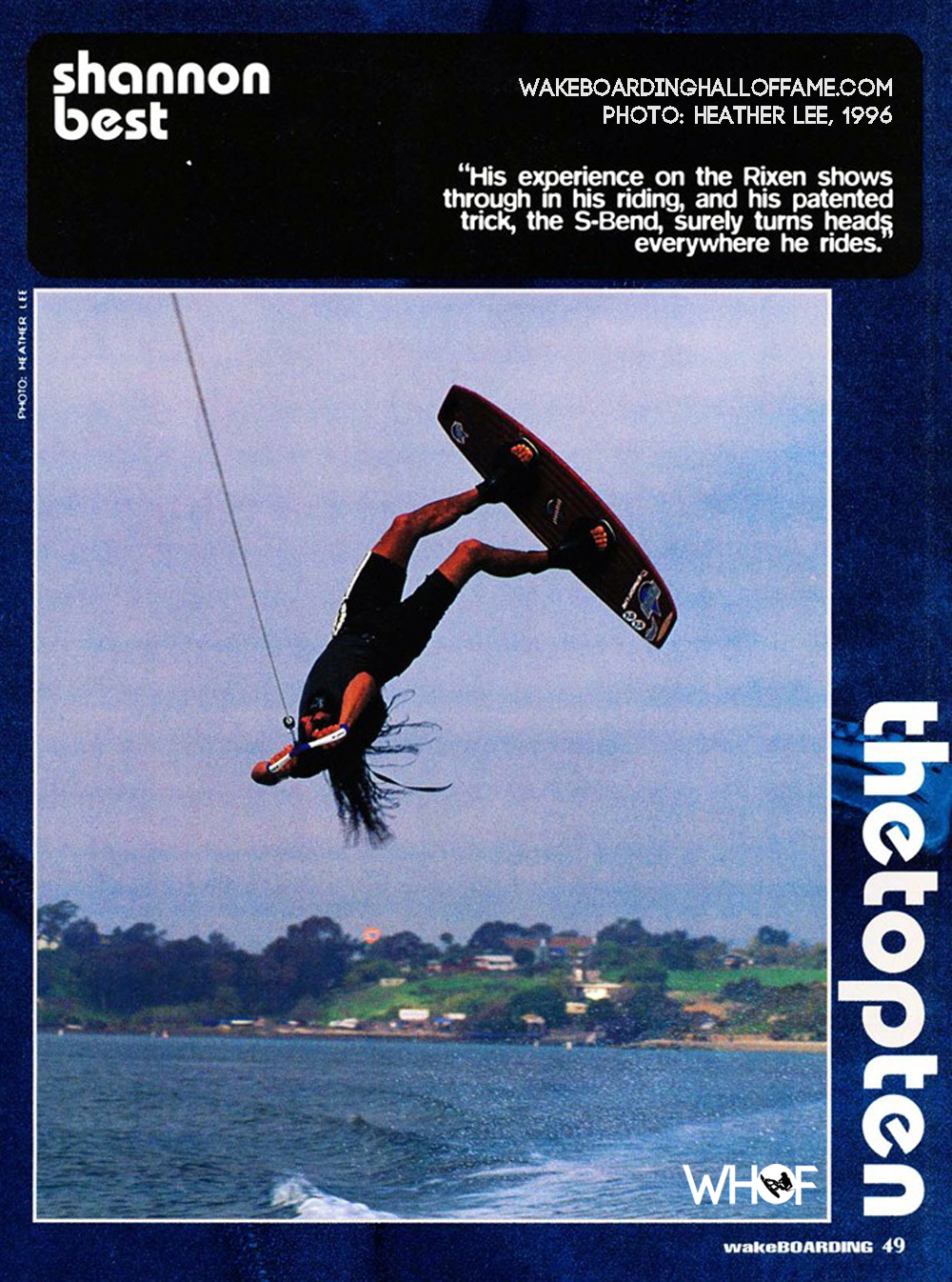
23 Mar The Best Interview: S-Bend Shannon
New Year’s Day – a symbol of renewal, hope, and rebirth; but for many people the yearly resolution to improve oneself wears off in a few days or weeks. Not so in the case of legendary waterman Shannon Best. New Year’s Day 1991 was the first step in a journey that was to forever change his life and create ripple effects that have carried down through decades in multiple board sport disciplines.
January 1st, 1991 was the Best day…Shannon first went to “Cable Ski World” on the Gold Coast of Australia. After a day of riding this huge cable park he was immediately hooked, got a job mowing lawns at the facility and eventually worked his way up to operator and finally manager. Along the way he became one of Australia’s best cable wakeboard riders, invented the S-Bend without even knowing it, and made his way to Florida to turn pro.
Best exploded onto the professional scene with his S-Bend behind the boat, became a perennial top five rider in WakeBoarding magazine, stood on the podium several times at the Masters, won multiple Pro Tour Stops, and punctuated his storied wakeboarding career with wins at the first WWA Cable Worlds in 1999.
For the next decade he turned his intentions to kiteboarding, using his cable and boat skills to help create a new way to ride behind a kite: wakestyle.
From his current home in Florida to the far flung beaches of Brazil, S. Best’s claim to fame still lives on: the S-Bend.
-Tony Klarich
WHOF: What was the state of Australian cable in 1991 when you started?
SB: Cable Ski World on the Gold Coast was heavily influenced by show skiing -Sea World was near by and performers were often around. Our park was probably the largest in the world with three separate systems, so people were riding just about everything – slalom skis, kneeboards, skurfers, barefooting…
WHOF: It’s interesting that you started riding the cable the exact same month and year that the first Hyperlite was introduced.
SB: We knew that the Hyperlite boards had been released in the US because of WaterSki magazine. I spent that first summer riding a blue McSki. It wasn’t till 1992 that I got one of the first four Hyperlite boards imported into Australia by Neil Harris. I think my Hyperlite Pro was something like $500 without shipping – but getting on that board was a game changer.
The Australian produced McSki was Shannon’s first ride, and the world’s first production skiboard.
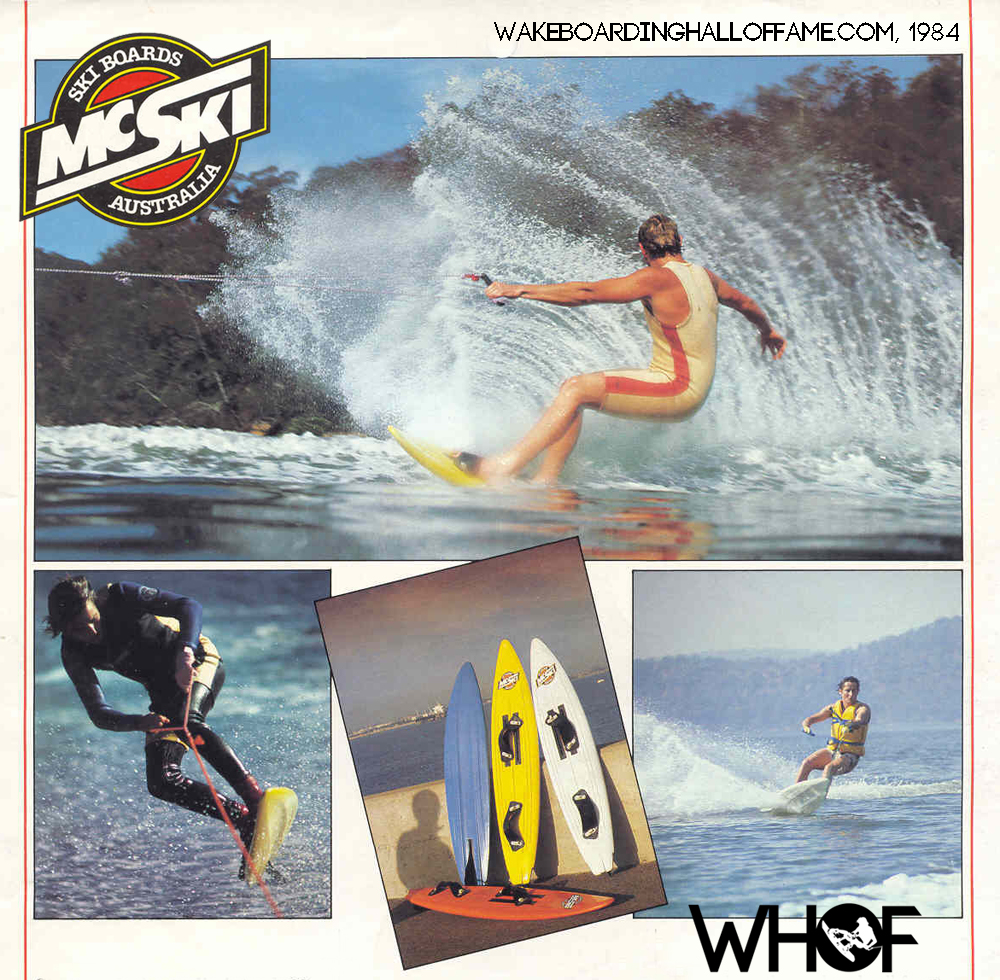
WHOF: What was the biggest move at the cable when you first started in 1991?
SB: We looked to the US WaterSki Magazine for inspiration, and the biggest cable move by far was the Flying Indian around the corner. You use a super short rope, then take a hard cut away at the corner to generate momentum against the rope.
WHOF: Yes that was Steve Fontaine in the mid 1980s, the “Etc.”, feature in WaterSki magazine.
SB: We were influenced by what was going on in WaterSki magazine, and Fontaine was on jumpers – because we had so many show skiers around who did freestyle jumping, that’s how they all did it too. On the skiboard side the top rider was Matt Hadley – he was a few years older and was at least a year advanced on everyone else. He was doing Flying Indians on his skiboard.
Steve Fontaine helped to popularize the Flying Indian with this 1986 “Etc.” feature. Photos, Tom King.
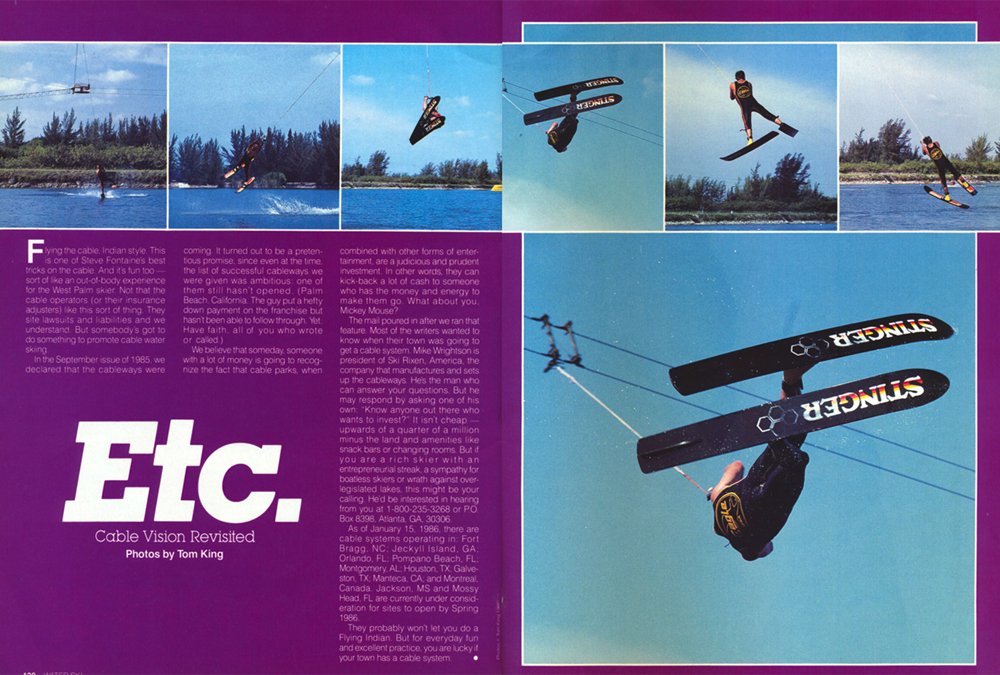
WHOF: So what was everyone else doing on the skiboards?
SB: 180s, any type of airs, taking your feet out of the bindings to hang five, laybacks in the corner…but it was Matt who was leading the way with his style. He left Cable Ski World on the Gold Coast for another cable park up north on the Sunshine Coast called Ski and Skurf. I really wanted to get better, so ended up following him up there – the rules were more relaxed and we were able to get more time on the short Indian rope.
Shannon launches a Flying Indian at the Quiet Waters cable park, 1995
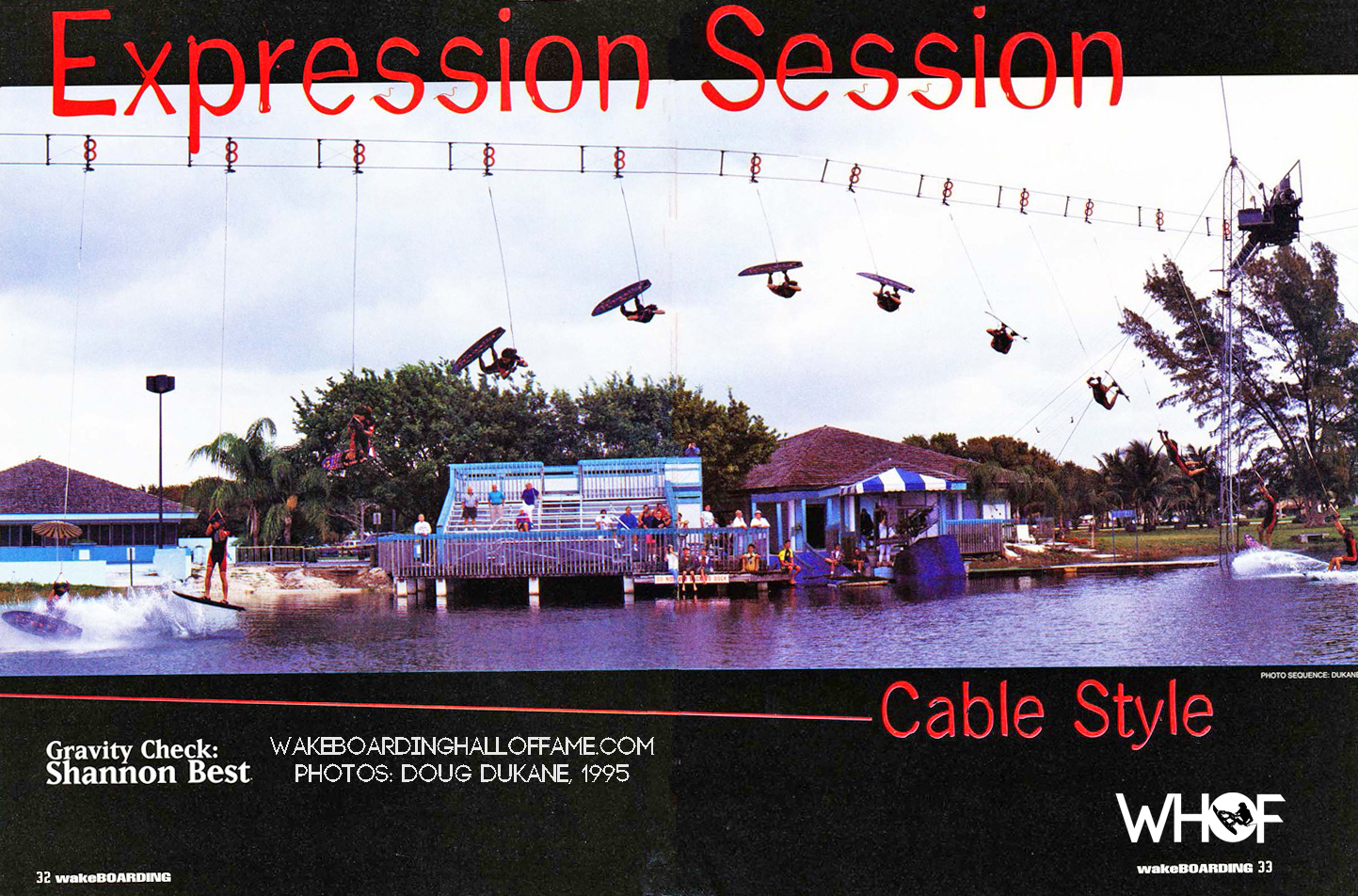
WHOF: Where did you find inspiration for riding?
SB: Matt of course, but there was a larger collection of riders up there pushing each other. I also rented out a Brett Wing’s Watersports video that showed him doing all kinds of amazing things on the water – he was the World Champ in barefooting, and also the best all around skier of his generation. He ran 38 off on slalom, did flips on a trick ski and freestyle jumpers, flew a kite, and did hot dog slalom skiing.
INFLUENCIAL: Brett Wing’s Watersports, 1986
[youtube id=”9uvffZb14_g” align=”left” autoplay=”no” maxwidth=”750″]
The whole Ski and Skurf cable crew was also influenced by your instructional video. The TV at Ski and Surf constantly played Hot Dog Slalom Skiing – all those tick tocks, 360s, and flips – the guys I rode with said if Tony can do those tricks at speed on a slalom ski, we can surely do them at half speed on our boards. So we did try a lot of those moves.
INFLUENTIAL: Hot Dog Slalom Skiing with Tony Klarich. Opening Montage, 1989.
[youtube id=”ix4kK3wbuIc” align=”left” autoplay=”no” maxwidth=”750″]
VIDEO PLAYLIST LINK: Hot Dog Slalom Skiing with Tony Klarich
WHOF: Then there was Darin and the Air Raley…
SB: That was in the first part of 1992, and by then I was back down south to Cable Ski World on the Gold Coast. I remember it very clearly in WaterSki magazine – it was a wetsuit ad with Darin doing this crazy trick. That photo blew us away. It’s iconic. We didn’t know what it was our how he was able to get into that position; but whatever it was, we all wanted to do it. Seeing that move did change the game. We all knew deep down that the Flying Indian wasn’t legit. Darin was behind the boat and straight out in a superman position. We thought to ourselves, “look this guy Shapiro in the States is doing it behind a boat. Someone has to be able to do it here long line on the cable.” It wasn’t long after seeing the photo that I started doing them longline on the cable, and was eventually able to do them just about anywhere in the course.
The fist Air Raley in print: April, 1992. Shapiro’s iconic ad was a game changer for wakeboarding.
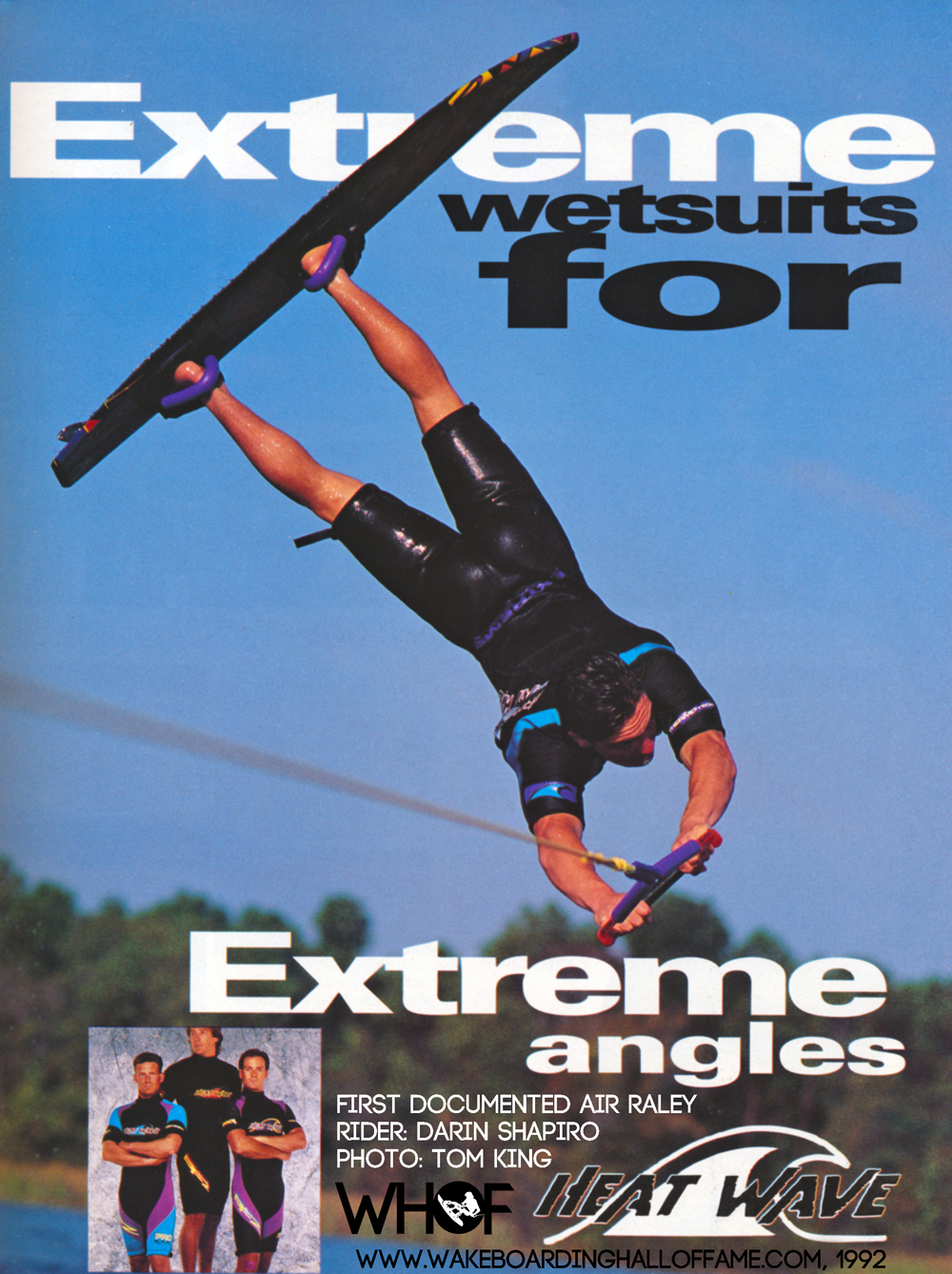
WHOF: So when did you start breaking out as a cable rider in Australia?
SB: Right when I came back down south to the Gold Coast cable park, I had just learned the Raley, plus tick tocks, air 360s, and even a tumbleturn. All the riders – there was probably a hundred of us between the two cable parks – were wearing barefoot suits made by Rubber Jungle.
WHOF: What about flips?
SB: The only guy doing flips was a trick skier. I think it was a back roll on a single trick ski. Seeing him and all the other flips from show skiing, kneeboarding, and hot dogging in the U.S. WaterSki Magazine was a motivation for me to try and take it to the next step too. So I decided to try a front flip on the cable. By this time I had switched from the Hyperlite Pro to the Connelly Blade. I threw what I thought was a front flip, but got stretched out into a Raley and did an overhead spin instead. My mates, many who were show skiers, gave me a hard time and called it an ugly move. I believed them. We all thought it was just an ugly attempt at a front flip. It was actually the S-bend, but since it wasn’t the front flip that I was trying to do, it just got shelved for awhile.
WHOF: Did you ride behind a boat much in Australia?
SB: No – it was way too expensive. Probably a total of four times, and that was a tournament boat with a low tow and small wake. The cable was where all the wakeboarding was developing.
WHOF: What inspired you to come to America?
SB: A mate of mine, Clayton Dunn was a show skier who spent 1992 doing shows in the U.S. He made a trip to the Quiet Waters cable park in Ft .Lauderdale, FL and was blown away by the level of wakeboarding – that was the home park of Darin Shapiro and other top U.S. riders and coaches like Mike Ferraro and Chet Raley. Clayton came back home for the off season, told me about it, and when he returned to the States for another season of show skiing in 1993 he dragged me along. I was a big fish in a small pond in Australia – it was time to go somewhere that would improve my riding – and that meant giving it a shot on the U.S. cable.
WHOF: So you came to the U.S. in May of 1993, at the end of the summer season in Australia. Did you get a job right away?
SB: I went straight to work at the Quiet Waters as an operator, and was really just a below average rider there. I was also lucky enough to move in with Jimmy Sposato who lived on a lake, and had a nice boat. Jimmy went on to win a National Championship behind the boat in Men’s II – I was fortunate to have a very good boat rider as a roommate.
WHOF: When did you throw that first S-Bend on the US cable?
SB: Sometime that first summer. I was improving fast…there were so many good riders and we were all pushing each other. So one day I told my mates check this out and just threw it – you’ve got remember I still thought it was just an ugly front flip – but the guys flipped out on it. With that response I kept doing it. I remember Darin coming to the cable and asking me to do it for him over and over – probably 20 times. I’m sure he was trying to figure out how to do it.
Classic Video: “Spray” from FLF Films. Shannon Best Cable Section, 1995
[youtube id=” YPcfejIyPTU ” align=”left” autoplay=”no” maxwidth=”750″]
WHOF: So how did the name S-Bend come about?
SB: That wasn’t for another the year when I did it behind the boat for the first time. I just called it a Raley with and overhead 360 in the beginning.
WHOF: How did you transfer the move from the cable to the boat?
SB: I was at the cable all day as an operator, and got in as much riding as I could. Then I would race home to ride behind the boat. It would have been the middle of 1993 when I first learned the Air Raley. My roommate Jimmy had a 1989 Ski Nautique and we put a bunch of ballast in it. But even with the extra weight I didn’t try an S-Bend behind the boat till the end of 1994 – more than a year later – the boat wakes were still too small and we were still riding on low pylons.
WHOF: So what did you do behind the boat that first year in Florida?
SB: Wakeboarding had just been added to the Pro Tour, and I knew some guys who were competing. Shapiro from the cable park, and there was another boarder who trained on the same lake as me. All the sponsorship and prize money was behind the boat, so it was just a natural progression to try and get good enough to qualify. It was a tough transition at first, but things came together later in the year. I was learning a new trick almost every set for weeks…all basic inverts I would need have a shot on tour in 1994.
WHOF: So how did you do your first year on tour?
SB: I usually trained by myself, so didn’t get a chance to see what everyone else was doing. No YouTube back then. When the tour started I was usually at the bottom of pack – around 7-8-9. I saw the new tricks on the weekend of the event, then was back on the water the following Monday figuring out how to land them. I got better and better as the season advanced, and so did my placements.
Shannon Best: New Kid on Tour, 1994
[youtube id=”4bcrxlA-ho0″ align=”left” autoplay=”no” maxwidth=”750″]
WHOF: Was throwing the S-Bend behind the boat on your mind at all during the season?
SB: I never really thought about it with everything that was happening on tour – plus the boat wakes were small and the rope was low. But when the Pro Tour was done for the year I was invited to do a photo shoot in the Keys with Doug Dukane. Doug had this big fishing boat with a tower that we used to tie high. Not the towers like on today’s boats, this was set up for fishing. That boat also had the biggest wake I had ever ridden. It felt great. I remember thinking this is how wakeboarding is supposed to feel, and wondered why all wakeboarding boats didn’t have towers. I launched a few big Air Raleys, and then just ripped one of my Raleys with an overhead spin. There was no pressure to try the trick. It wasn’t premeditated. I just started throwing them and was successful right away. Doug was frantically swapping camera and loading film in the boat. We all knew it was something special right away.
Doug Dukane’s “fishing boat” was popular with early wakeboarders because of the tower and big wake.
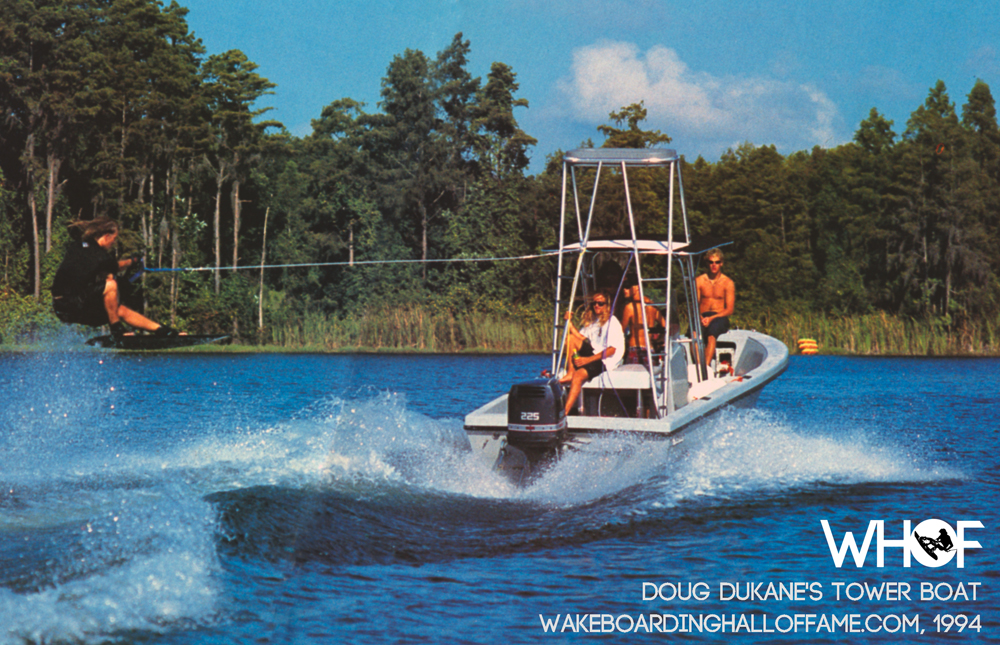
WHOF: So this is where you finally named the big move?
SB: Yes…Tom James, the first editor of WakeBoarding magazine called me up and said the trick had to have a name because he was running a sequence in the first issue of 1995. How I named it is a bit of a story that goes back to grade school. I used to sign my name S. Best as a kid, and I had a teacher who made fun of me saying – what is this s-bend? It’s kind of an Aussie joke because the s-bend is a part on the back of a toilet.
WHOF: So it was a bit of toilet humor, literally?
SB: Yes, and later I remember listening to TISM, and alternative rock band that had some lyrics referring to the s-bend too. Aussies from my generation know what s-bend refers to. We would say something like “don’t do something dumb or you would wind up in the s-bend.” In other words if you screw up then you will end up in the shitter – kind of like trying my trick. So with the deadline of having to come up with a name I just told Tom James to use S-Bend kind of as a joke – but the name has stuck now for more than two decades.
WHOF: I always thought it was a play on the “S” in Shannon, and that you were “bending” an Air Raley.
SB: I don’t think very many people figured it out, especially outside of Australia. And I never really told anyone till now except for a small circle of friends.
WHOF: So when did you unveil the move in public?
SB: It was the very first Pro Tour Stop of the 1995 season. The format back then was two-passes with five scored tricks in each pass. If you stood up the second pass, then you got to try a Wild Card Trick. Gator did a Hoochie Glide, and I did the S-Bend at that event. If you landed the trick, then Jimmy Redmond who was chief judge of the WWA, would give it a point value, and the rider got to officially name it. With an assigned point value you could then do it as part of you regular trick runs.
WHOF: So you put in your runs right away?
SB: I didn’t do it on tour because I couldn’t get consistent on it with the small wake and low tow we used that year. I did throw one during the Master’s qualifier in the middle of the 1995 season, but fell super hard when I came up short. My board delaminated and I got short circuited, but still managed to qualify for Masters and did well that year. It was a different story for the Team Challenge event held in conjunction with Surf Expo – it was the last tournament of the year and we used a Skylon for the first time in a tournament. I had just started using a Skylon in practice and loved it because of the upward pull and that it was a little springy just like the cable. At the Team Challenge some of the judges in the boat had never seen the S-Bend in real life, and when I rode away it was enough to clinch the win against Darin Shapiro.
Best used a Skylon to boost his S-Bend. Result: Individual Champion at the 1995 Wakeboarding Magazine Team Challenge
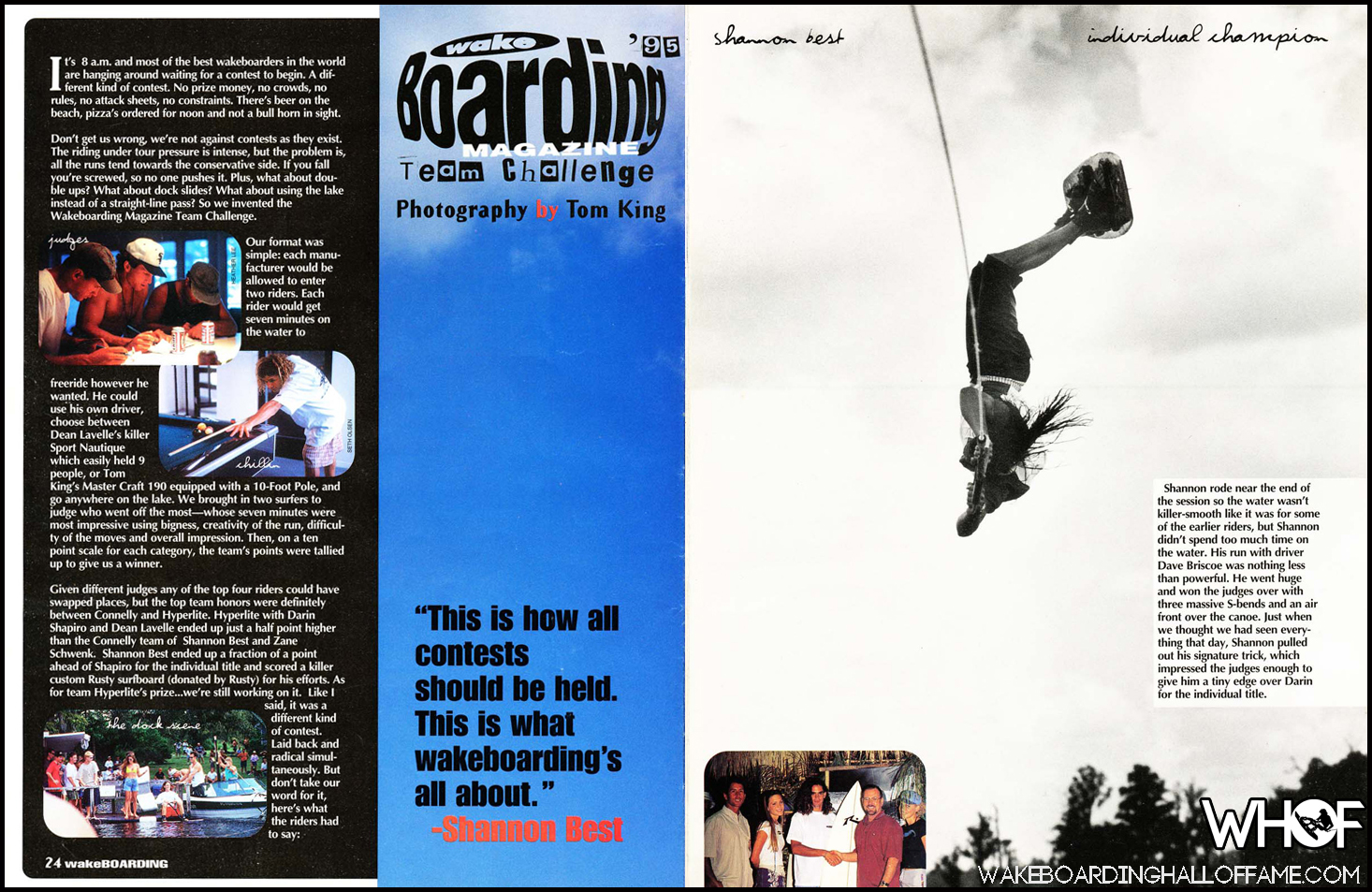
WHOF: What was the general reaction to the trick?
SB: People were blown away when they saw it. During early photo shoots I was asked to do it over and over. Then everywhere I went for exhibitions and demos I was always known as the guy who does the S-Bend. People expected to see it, no matter what the riding conditions.
Shannon, his S-Bend and a Skylon as the featured “Inside” spread for Wakeboarding Magazine, 1997
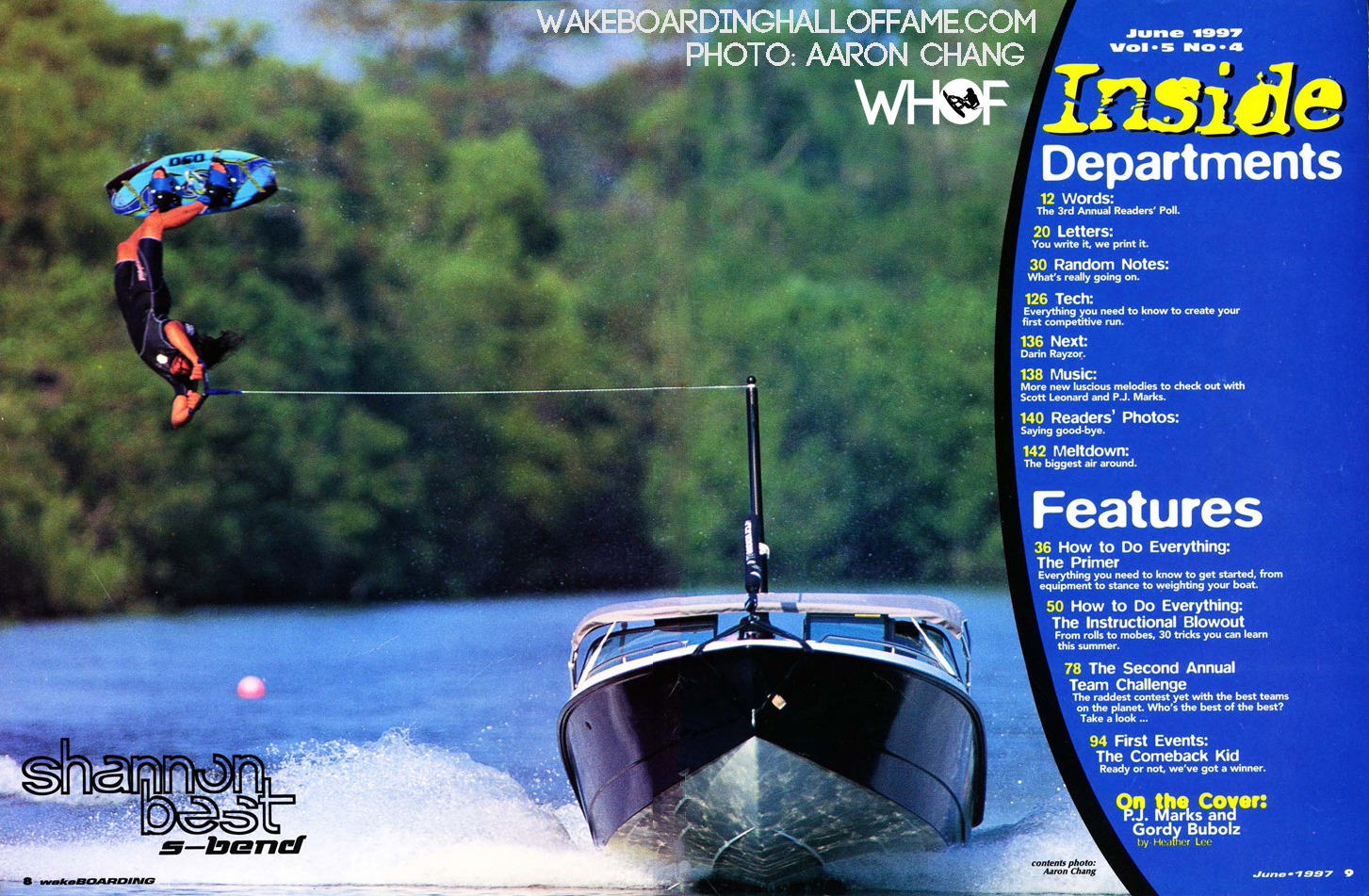
WHOF: How long was it before other riders started doing it too?
SB: Things moved at a much slower pace back then. It took a long time for things to get out. It really was much easier to do the S-Bend on the cable, especially back then. It took a 100% commitment behind the boat, and you had to hunker down to build up a lot of speed coming into the wake. It was hard for guys who skipped the cable and went straight to the boat. Most early guys tried it like Shapiro, Byerly, Dean Lavelle…
WHOF: What about variations on the move?
SB: The big ones were S-Bend to revert and S-Bend to blind. I did those first on the cable. I also did the S-Bend to revert behind the boat early on, but since Parks was the first one to land it in a competition – I think it was the X-Games – he ended up naming it the Vulcan.
WHOF: Were you also the fist one to do it kiteboarding?
SB: No. That would have been Lou Wainmen. He rode the Quiet Waters cable park quite a bit especially in 1993-94 – I taught him how to do the S-Bend there. He became a pretty good cable wakeboarder, but went on to become a kiteboarding legend – he’s kind of the kiteboarding version of Byerly – a style rider who changed the game. He has since credited me as an influence in his style of riding.
WHOF: Speaking of kiteboarding, in 1999 you had a timely encounter with Tom James former founding editor of Wakeboarding magazine who had just become creator and editor of Kiteboarding magazine, the first major publication to cover the sport.
SB: Tom was a visionary, and he always was at the start of something new. I’m very thankful he called me up to go out kiteboarding with a group that included Lou Wainman, Zane Schwenk, and Chase Heavener. Our trip was documented in the premier edition of Kiteboarding magazine.
WHOF: So this trip got you hooked on kiteboarding?
SB: Not right away, although I was able to do some decent jumps during that first trip. I was still wakeboarding, but my career behind the boat was winding down. I was one of the lucky few to have a boat sponsorship from Supra, but I lost my board sponsorship and that put me in limbo for 1999. So I decided to shift my focus back to cable. OWC had just opened up in Orlando and they really started pushing the cable. The first WWA Cable Worlds were held there in conjunction with Surf Expo at the end of the year. All the big names competed – Parks, Darin, Shane Bonifay to name a few – and all the industry guys were there because of Expo. It was the first really big event for cable wakeboarding and I won Big Air and Freestyle.
WHOF: So that was like the crown on your wakeboarding career? It was time to go out on top?
SB: I never really planned to make the switch to kiteboarding, it was just an organic change. After the WWA Cable Worlds it got really windy in south Florida. I already knew a few kiteboarders, and they invited me out. That’s when I really learned how to fly the kite properly. It just became a smooth transition, and the tricks came easily because of my background in wakeboarding and cable riding. I made the switch to kiteboarding at the right time. Most kiteboarders were riding directional boards, and very few people were going upwind because it was hard to ride switch or frontside. With the launch of Kiteboarding magazine sponsorship dollars were starting to come into the sport. I was getting better fast and went to the Waddell Creek Challenge – the biggest kiteboarding competition at the time. I ran into Lou Wainman at he event and when he saw what I was doing, he invited me to pack up and move in with him in Maui.
WHOF: You are often credited along with Lou Wainman for bringing wakestyle into kiteboarding. What does that mean to you?
SB: Lou was the main guy who introduced wakestyle. He was influenced from our days wakeboarding on the cable. When I came along it was just natural to do all my cable tricks, but with so much more hang time it was super easy to transfer them over – double S-Bends to blind in both directions, lots of handle-pass tricks – that is a main thing for wakestyle.
Lou Wainman wakestyle kiteboarding with a handle-pass trick.
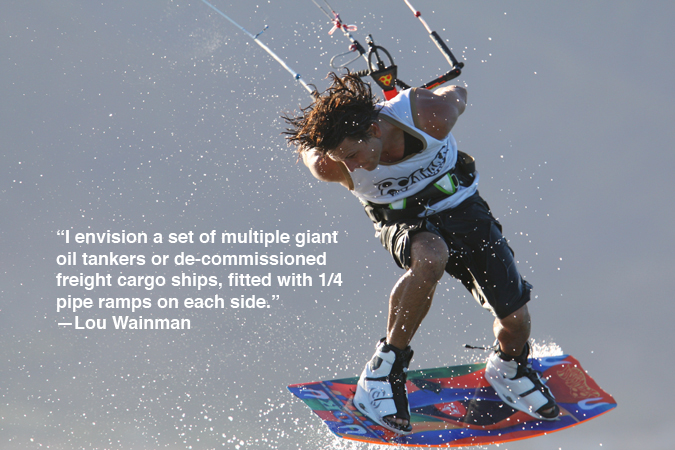
WEB LINK: From Sbckiteboarding.com – Lou Wainman Interview
WHOF: How was wakestyle received in the kiteboarding community?
SB: Not well at first. The first kiteboarders were old crusty guys who had come over from windsurfing. They were an older set who were worried about the wakeboarding mentality creeping into the sport.
WHOF: And you represented the wakeboarding element?
SB: That’s where it all came from for me. Those old guys used larger directional boards, and the new crew was on smaller twin boards. We used boot binding and these guys were still using footstraps like the early Skurfer and windsurfer days.
Wakestyle kiteboarding from Best: adding the element of sliders from wakeboarding.
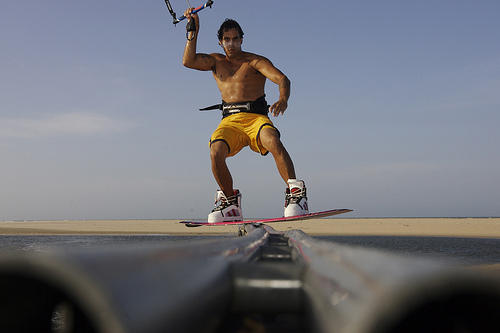
WHOF: You were ranked as a Top 10 wakeboarder for most of the 1990s, usually around #5. How did you stack up as a kiteboarder?
SB: I did very little competition. In 10 years I went to maybe only a dozen contests. The main competition events were Big Air, Racing, and Freestyle. I did make it onto the podium every time I competed, and even beat a few World Champions – but competition was not my main focus. I was the co-founder and owner of Best Boards for a few years. I also created a couple of instructional videos that were well received.
WHOF: So what’s next?
SB: I’m currently taking a hiatus from kiteboarding – I’m just a recreational rider right now. I’ve been flipping houses in Florida in the meantime. I think my future will take me back to wakeboarding and a cable park – but the next time around I’ll be a little more than a rider and operator.
RELATED CONTENT
WEB LINK: Shannon Best WHOF Bio
WEB LINK: Cool Interview on Shannon, from Cable to Wake to Kite
Shannon Best: Ski Rixen, 2007
[youtube id=”qSTc5kzbxy8″ align=”left” autoplay=”no” maxwidth=”750″]
Shannon Best kiteboarding with JoJo in Brazil
[youtube id=”NR3e5uApxE4″ align=”left” autoplay=”no” maxwidth=”750″]
WEB LINK: History of the Layout by Tony KLarich


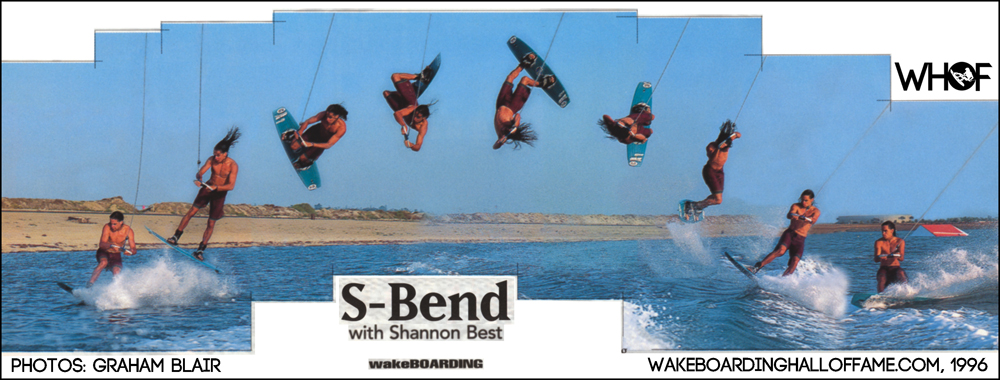
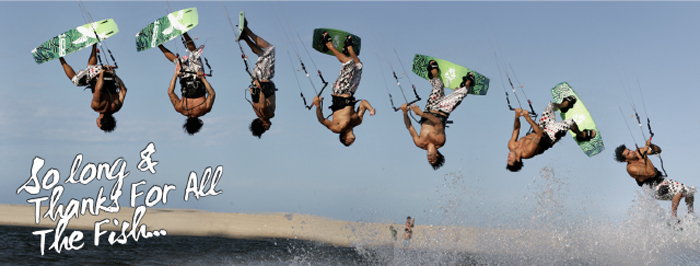
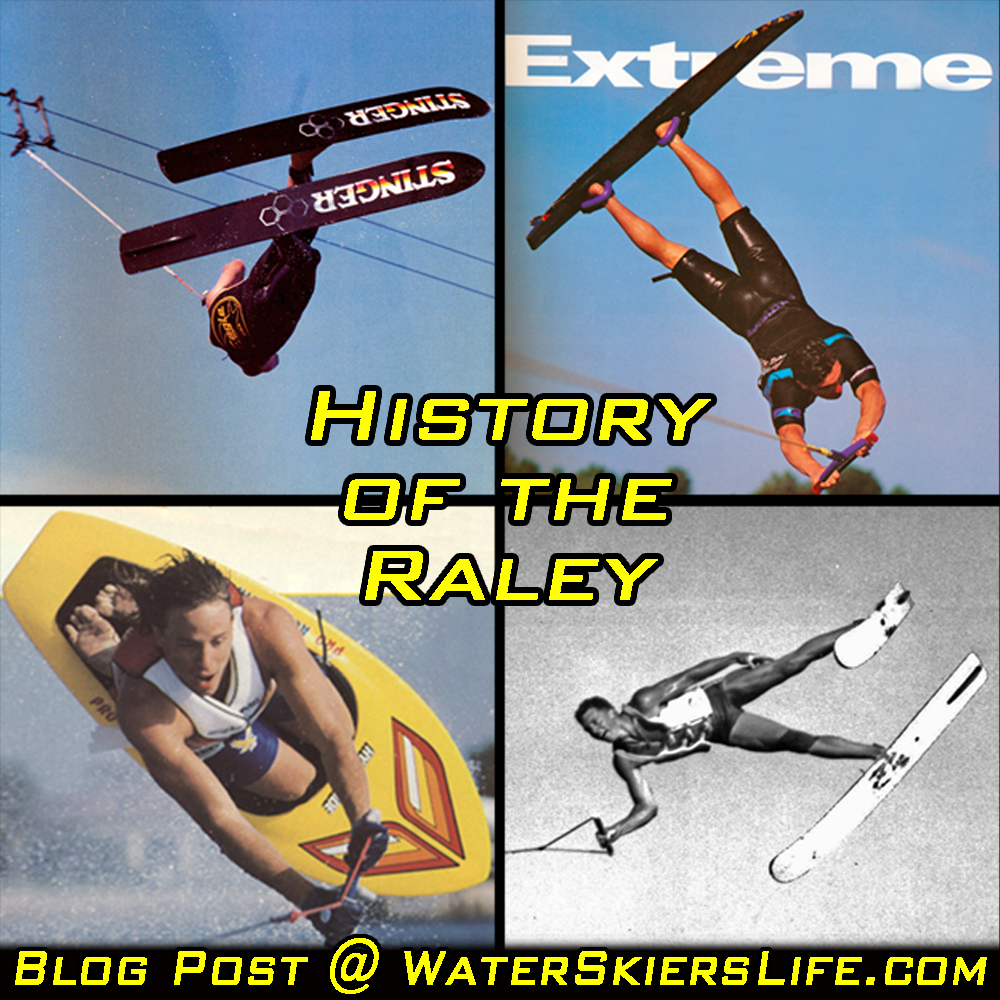
Sorry, the comment form is closed at this time.